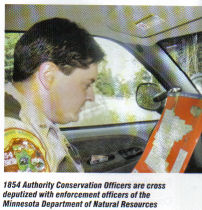Conservation
Enforcement by the 1854 Authority
 Minnesota's
northeastern Arrowhead region is one of the most beautiful
areas in
the world. A product of what ecologists call the "Canadian Shield",
this region is home to the Superior Minnesota's
northeastern Arrowhead region is one of the most beautiful
areas in
the world. A product of what ecologists call the "Canadian Shield",
this region is home to the Superior
National Forest and the Boundary Waters Canoe Area Wilderness(BWCAW). Within
this area is the largest eastern gray wolf population in the lower 48 states,
a sustainable
moose population, as well as deer,various small game, fish, wild rice and other
natural
resources. Minnesota is called the "Land of 10,000 Lakes" and the
Arrowhead is a tourist mecca. It has been estimated that the state actually
has over 12,000
lakes with the Arrowhead region having a large share of them. Located
within this area is the Ceded Territory of 1854.
Historically, the Treaty
of 1854 is the result of transfer of more than five million acres of land,
including those
bordering Lake Superior, from the Chippewa
of Lake Superior to the United States Government on September 30th of
that year. The Lake Superior Chippewa retained the right to hunt, fish and
gather in this ceded territory. As a result,
they and the State of Minnesota cooperatively manage enforcement of
the treaty rights.
In 1988 the Boise Forte, Grand Portage and Fond du Lac Bands entered into
a negotiated agreement with the State of Minnesota. As a result of this agreement,
these signatories
agreed to limit certain off reservation rights. These Bands would in turn
receive
an annual monetary payment from the state. The Tri Band Authority was formed
the same year to manage off reservation harvests. In 1989 the Fond du Lac
Band pulled out of the agreement, which was allowed per a previous stipulation.
The Tri Band Authority then became the 1854 Authority that is the intertribal
natural
resource management agency for off reservation hunting, fishing and gathering
rights in the 1854 Ceded Territory. Funding for the 1854 Authority program
is received from the Bureau of Indian Affairs and is implemented through
the Public Law 638 contract.
The headquarters of the ten person 1854 Authority
is located in Duluth, Minnesota
and consists of an Administrative, Biological Services and Enforcement Division.
The 1854 Authority executive director reports to a chairperson, who in
turn reports to a board of directors, which is made up of representatives from
both the Boise Forte and Grand Portage reservation tribal councils. The enforcement
division reports to the executive director.
Subscribe
and get the whole story.
|
The enforcement division in full compliment consists of four full time conservation
officers. There is a lieutenant, sergeant, and
two field officers. The lieutenant and sergeant, in addition to administrative
duties, also work as field officers. Each officer is Minnesota state licensed
and is cross deputized with enforcement officers of the Minnesota Department
of Natural Resources. Each 1854 Authority conservation
officer must be licensed by the Minnesota Peace Officers Standards and Training
(POST) Board. To be licensed
as a peace officer in
Minnesota an individual must complete a minimum of 96 quarter
credits of college with half of those credits being criminal justice related,
a skills
component (similar to a police academy), and pass a written state test. At
that point the candidate officer is eligible to be licensed. Upon being hired
by a licensing agency the candidate is licensed as a Minnesota peace officer.
The Minnesota Department of Natural Resources Enforcement Division currently
is the 1854 Authority's licensing agency and as a result, holds the 1854
Authority conservation officer's license. To maintain a Minnesota Peace Officer
License,
each officer must complete a minimum of 48 hours of training every three
years which includes mandatory course work in the areas of use of force,
defensive
tactics, day, night and cold weather shooting qualifications, driving, HAZ
MAT and bloodborne pathogens.
 The
1854 Authority conservation officers are responsible for enforcing off
reservation treaty rights per the 1854 Conservation Code and state fish
and game statutes
within the ceded territory. This includes angling, netting, hunting, and
trapping as well as the harvest of wild rice, maple syrup and other vegetation.
Being licensed peace officers they may, in addition, enforce all Minnesota
state laws. The
1854 Authority conservation officers are responsible for enforcing off
reservation treaty rights per the 1854 Conservation Code and state fish
and game statutes
within the ceded territory. This includes angling, netting, hunting, and
trapping as well as the harvest of wild rice, maple syrup and other vegetation.
Being licensed peace officers they may, in addition, enforce all Minnesota
state laws.
There are four conservation officers employed at the 1854 Authority. Lt.
Leo Vidal lives near Babbitt, Minnesota, which is in the north central
area of
the ceded territory. Part of his patrol area is the Boundary Waters Canoe
Area Wilderness. The Authority has employed him for over ten years. He
was a field
officer for seven years before becoming a supervisor. Vidal is a member
of the Boise Forte Band of Chippewa and oversees the enforcement division.
He is a Life Member in the North American
Wildlife Officers Association (NAWEOA).The Authority has employed Sergeant
Bill Myers since May of 1990. He is the only remaining original officer.
Subscribe
and get the whole story.
|

